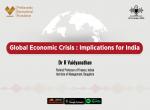Prime Minister Narendra Modi was voted into power on the basis of some very clear ideas and promises of getting the economy back on track, creating lots of jobs and on making India an easier place to do business for both Indian and foreign companies. This first budget is therefore an important signal of his government’s commitment to following through on its promises. This was a complex budget and the longest ever budget speech by a Finance Minister. There is a confusing amount of detail and new proposals and it is easy to miss the forest for the trees. In assessing this budget, I believe it is important to step back and ask four critical questions.
The first is fiscal consolidation. How does the FM plan to reduce expenditure, attack subsidies, raise money through disinvestment.?
The FM has promised to rein in government expenditure and maintain the deficit to 4.1% of GDP and reduce that to 3.6% then 3% over the next two years. He has appointed a high level Expenditure Management Commission to focus on curbing spending; more details are awaited but the intent seems clear.
He has also set a target of raising $13B through disinvestment. There is a special focus on government-owned banks, which must raise $40 billion by 2018 to recapitalize themselves. A booming stock market should help the government achieve its target.
Subsidies are a different matter. There is disappointingly little detail in terms of reining in the US$43bn subsidy regime which accounts 14% of all expenditure. Saying that the government proposes to "overhaul the subsidy regime, including food and petroleum subsidies, and make it more targeted while providing full protection to the marginalized, poor" and linking programs like MNREGA to asset creation amounts to a motherhood statement. More specificity is necessary.
Overall, these are directionally correct measures but given the harsh economic situation, the weak execution capability and the absence of details, restraining the deficit to 4.1% may be aspirational.
The second big question is what is the progress towards shifting to a more open economy with less friction? Basically this is about two things taxation and FDI.
The single biggest expectation of the world was that FM would repeal the retrospective amendment of tax laws on indirect transfers- the infamous Vodafone case. The FM emphasized the importance of a stable and predictable tax regime and set up a high level committee to deal with future issues but left the Vodafone matter to the legal system. This may have been pragmatic but failed to send the unambiguous signal foreign businesses are looking for, However, there are also changes proposed to make transfer pricing laws more consistent with international practices; this will greatly alleviate the concerns of MNCs.
While there are promises about action on the much awaited taxation reforms—Goods and Services Tax (GST) and Direct Tax Code—there is nothing concrete on either front. On GST, the FM said the government is ready to approve a legislative scheme to enable the introduction of a GST, but didn’t really deal with the revenue loss concerns of the states which have to approve this nor did he set a deadline for the implementation of GST.
On foreign direct investment, the FM has opened up FDI in ecommerce, and upped the cap on FDI in defence & insurance to 49 per cent, from 26 per cent previously. This is good but perhaps doesn’t go far enough. Defence contractors may be reluctant to part with technology unless they control 51%
Question # 3 is what is government intending to do to improve India’s dreadful infrastructure?
The FM did well here. He has committed large allocations to infrastructure- over Rs.37,000 crore for 8500 km of new roads, fuel guarantees for thermal power plans, a focus on developing new airports in tier 2 & 3 cities and 16 new ports and an additional 15000km gas grid and so on.
But more importantly, he has proposed several ideas to facilitate better policy framework for execution of projects as he looks to tap private sector investment . For instance, an eBiz platform that will bring in transparency and accountability into the process of getting statutory clearances such as land acquisition, environment and forest clearances which are major hurdles for project implementation.
To help fund infrastructure projects, the FM has encouraged banks to extend long-term loans to infrastructure sector. Banks will be permitted to raise long-term funds for lending to infrastructure sector with minimum regulatory pre-emption. In another move that could mobilize large investments, the FM announced infrastructure investment trusts similar to those for real estate. These are all practical and positive steps.
The fourth and final question is How does the government intend to create a vibrant manufacturing sector that creates lots of jobs?
Here the biggest impact will be indirect and felt over time through the implementation of GST and through improvements in infrastructure. Infrastructure projects in particular will trigger demand for construction machinery to cement and steel. Besides these, the increase in defence production, increased Custom duties on some electronics products and the expansion of an existing Tax incentive for large investments will all help.
There are many who are disappointed with the incrementalism of this budget. They expected bigger reforms and more details on the How’s. I am not one of them. I believe this budget is pragmatic and directionally sound. There is nothing retrograde and that in itself is a big deal after the experience of the last few years. A journey of a thousand miles begins with a single step and that’s what this budget really represents; in seven months, the government will present another budget for the full year and have an opportunity to be clearer and bolder. In any case, much of what is needed to be done to revive the economy lies beyond the budget- in legislative reforms and in administration. So, while there is great appetite for grand vision and big pronouncements, what we really need is better execution. If the government is able to avoid bruising confrontations and can actually deliver on what it has set out, it would represent substantial progress in an economy crippled by empty rhetoric, bad ideas, red-tape, and corruption.
(Ravi Venkatesan is the former Chairman of Microsoft India and Cummins India. He is a Director on the Boards of Infosys Ltd and Rockefeller Foundation and author of the book, “Conquering the Chaos: Win in India, Win Everywhere” published by Harvard Business Review.)
Published Date: 15th July 2014, Image source: http://st1.bgr.in
(Disclaimer: The views and opinions expressed in this article are those of the author and do not necessarily reflect the official policy or position of the Vivekananda International Foundation)








Post new comment